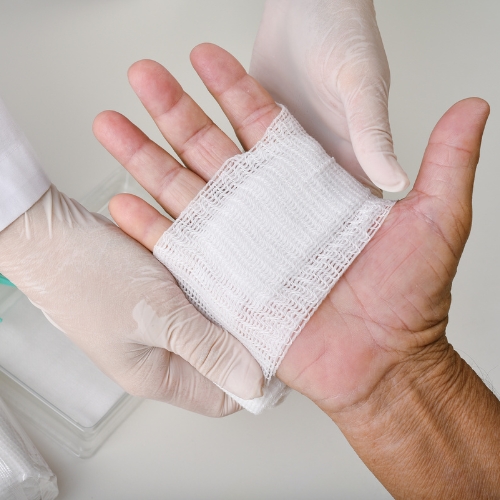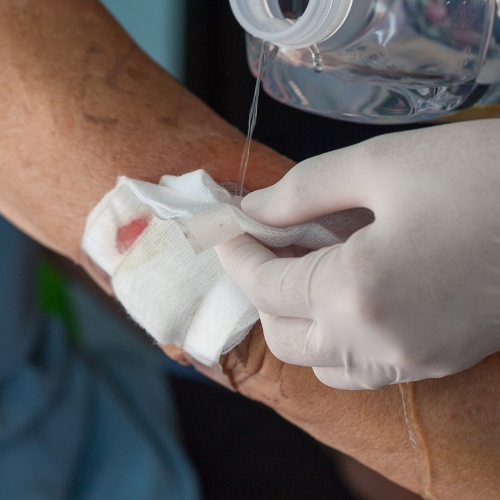OUR ADVANTAGES
Wounds Healing Stages and Followup Treatment
Chronic wounds and burns arising from trauma, surgery, infections, diabetes, and other underlying conditions, unfold a remarkable tale of the human body’s resilience and its innate ability to regenerate.

Diabetic Ulcers

Venous Ulcers

Slow or non-healing wounds

Venous Ulcers

Surgical wounds

Healing States
Book Now ›

Chronic Wounds

Chronic wounds, on the other hand, are typically associated with underlying health issues such as diabetes, poor circulation, or infection. They often get stuck in the inflammatory phase and struggle to progress through the healing process. Chronic wound healing can be summarized as follows:
Inflammatory Stalemate: Chronic wounds tend to remain stuck in the inflammation phase due to various factors, including poor blood supply, persistent infection, or ongoing tissue damage. This prolonged inflammation can prevent the wound from progressing to the next stages of healing.
Delayed or Impaired Proliferation: In chronic wounds, the production of collagen and the formation of new blood vessels may be delayed or impaired, making it difficult for the wound to close and heal properly.
Persistent Infection: Chronic wounds are often prone to infection, which can further hinder the healing process. Biofilms (bacterial colonies) can develop in the wound, making it challenging to eliminate the infection.
Underlying Health Issues: Conditions like diabetes or venous insufficiency can compromise the body’s ability to heal wounds. These underlying health issues must be managed to improve the chances of successful wound healing.
Acute Wounds

Injuries, surgery, or trauma typically cause acute wounds. Acute wounds, like stars in the night sky, illuminate the canvas of our bodies with a captivating ballet of healing. From the first drop of blood to the final bow of recovery, the stages of acute wound healing are a masterpiece of precision and timing. Let’s explore this enchanting journey through the lens of a whimsical theater production.
Hemostasis – The Grand Opening (0-2 hours) As the curtain rises, the stage is bathed in crimson hues. Platelets, the first performers, gracefully glide onto the scene, adorned in shimmering costumes. They create a splendid tableau, orchestrating a delicate dance with clotting factors, sealing the wound with a standing ovation from the audience of red blood cells. This act unfolds in mere hours, setting the stage for the drama to come.
Inflammation – The Fire of Emotions (2-48 hours) The stage is now ablaze with vibrant colors as the inflammatory cells take center stage. Neutrophils, the fiery soloists, arrive with a bang, while macrophages, the gentle healers, follow in their wake. Together, they perform a passionate duet, cleansing the wound and enacting a fervent drama of redness, swelling, and pain. This act, a whirlwind of emotions, lasts for up to two days.
Proliferation – The Flourishing Garden (2-3 days to 3 weeks) As the flames of inflammation subside, fibroblasts, the gardeners of healing, step forward in elegant costumes adorned with collagen blooms. They meticulously weave a tapestry of new tissue, and the blood vessels twirl into a mesmerizing dance of regeneration. Epithelial cells, the graceful ballerinas, glide across the wound’s stage, knitting it together with a delicate performance. This act can stretch from days to weeks, marking a period of intense creativity.
Remodeling – The Grand Finale (3 weeks to 2 years) With a flourish, the stage transforms into a gallery of artistry. Enzymes, the sculptors of the body, meticulously chisel away excess collagen and reshape the scar. It’s a long and patient process, a timeless ballet of perfection that can extend over months to years. The final bow is taken, and the scar, though forever changed, tells a tale of resilience.
Consultation Requirements – Backstage Pass: To ensure this magical performance, a skilled wound care consultant plays the role of the director, guiding the cast through their roles. They assess the wound’s needs, evaluate the patient’s health, and prescribe the right treatments. The consultation requirements include a careful examination of the wound, consideration of underlying conditions, and a tailored plan to support each stage of healing.
Recovery – Applause and Encore: Recovery is the encore to this splendid show. It varies from person to person, with some wounds healing completely and others leaving behind a graceful scar. Patients are advised to follow post-wound care instructions, including dressings, medications, and lifestyle modifications, to ensure the healing journey reaches its triumphant conclusion.
In the theater of acute wound healing, timing, consultation, and recovery are essential elements that transform a traumatic event into a beautifully orchestrated performance of resilience, patience, and transformation.
Call us
(281) 779-4045
Diabetic Ulcers
Diabetes can significantly impact the wound-healing process due to issues like reduced blood circulation and nerve damage. The stages of wound healing in the context of diabetes are similar to the general wound healing process but may progress more slowly or face complications. Here are the stages:
Hemostasis: This initial stage involves the body’s response to stop bleeding. Blood vessels constrict to reduce blood loss, and platelets create clots to seal the wound. Diabetes can affect blood flow, potentially prolonging this stage.
Inflammation: Inflammation begins shortly after the wound occurs. Immune cells, like neutrophils and macrophages, rush to the site to clear away bacteria and debris. Diabetes may weaken the immune response, making it less effective in controlling infection.
Proliferation: During this stage, the body starts rebuilding the damaged tissue. Fibroblasts produce collagen to create a framework for new tissue growth. However, in diabetes, high blood sugar levels can inhibit collagen production and impair blood vessel formation, slowing down this phase.
Remodeling: The final stage involves reshaping and strengthening the tissue. Enzymes break down excess collagen, and the scar becomes more refined over time. Due to diabetes-related complications, scars may be thicker and take longer to mature.
Diabetes Wound Healing Stages
| Stage | Description |
|---|---|
| Act 1 | The Quiet Menace - Initial Injury |
| Act 2 | The Gathering Storm - Infection and Inflammation |
| Act 3 | The Resilient Hero - Proliferation and Repair |
| Act 4 | The Scarlet Badge - Scar Formation and Remodeling |
| Epilogue | The Ongoing Saga |
TESTIMONIAL
What our clients say

“Sed ut perspiciatis unde omnis iste natus sit voluptatem accusantium doloremque laudantium, totam rem aperiam ipsa quae ab illo veritatis quasi architecto vitae dicta sunt semteur explicabo nemo enim.”

